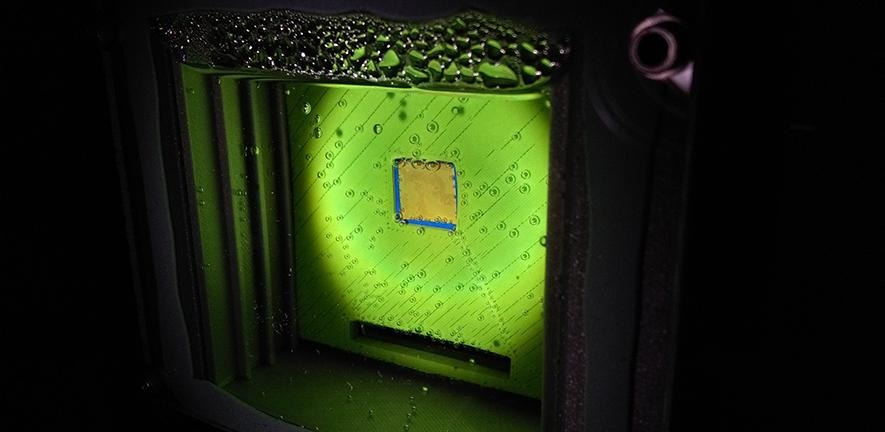Oct 22 2019
An extensively-used gas that is presently made from fossil fuels can instead be made using an “artificial leaf” that utilizes only sunlight, water, and carbon dioxide, and which could ultimately be used to create a sustainable liquid fuel substitute for petrol.
 Artificial leaf. (Image credit: Virgil Andrei)
Artificial leaf. (Image credit: Virgil Andrei)
The carbon-neutral device fixes a new standard in the field of solar fuels, after scientists at the University of Cambridge showed that it can directly create the gas—known as syngas—in a sustainable and basic manner.
Instead of working on fossil fuels, the artificial leaf is driven by sunlight, and still functions efficiently on cloudy and grey days. Furthermore, in contrast to the existing industrial processes for making syngas, the leaf does not discharge any extra carbon dioxide into the atmosphere. The results have been published in the journal Nature Materials.
Syngas is presently produced from a mixture of carbon monoxide and hydrogen, and is used to manufacture a variety of commodities, such as fuels, plastics, pharmaceuticals, and fertilizers.
"You may not have heard of syngas itself but every day, you consume products that were created using it. Being able to produce it sustainably would be a critical step in closing the global carbon cycle and establishing a sustainable chemical and fuel industry," said senior author Professor Erwin Reisner from Cambridge's Department of Chemistry, who has spent seven years pursuing this goal.
The device, Reisner and his colleagues built, was inspired by photosynthesis—the natural process by which plants use sun’s energy to convert carbon dioxide into food.
The artificial leaf has two light absorbers, akin to the molecules in plants that make use of sunlight, that are integrated with a catalyst made from the naturally rich element cobalt.
When the device is soaked in water, one light absorber uses the catalyst to create oxygen. The other performs the chemical reaction that reduces carbon dioxide and water into hydrogen and carbon monoxide, developing the syngas mixture.
As a bonus, the scientists learned that their light absorbers function even under the low intensities of sunlight on a rainy or cloudy day.
This means you are not limited to using this technology just in warm countries, or only operating the process during the summer months. You could use it from dawn until dusk, anywhere in the world.
Virgil Andrei, Study First Author and PhD Student, University of Cambridge
The study was done at the Christian Doppler Laboratory for Sustainable SynGas Chemistry in the University's Department of Chemistry. It was co-sponsored by the Austrian government and the Austrian petrochemical company OMV, which is seeking ways to make its business more viable.
OMV has been an avid supporter of the Christian Doppler Laboratory for the past seven years. The team's fundamental research to produce syngas as the basis for liquid fuel in a carbon neutral way is ground-breaking.
Michael-Dieter Ulbrich, Senior Advisor, OMV
Other “artificial leaf” devices have also been designed, but these typically just make hydrogen.
Thanks to the mixture of materials and catalysts the Cambridge team used, their leaf was able to yield syngas sustainably.
These include advanced perovskite light absorbers, which offer a high photovoltage and electrical current to drive the chemical reaction by which carbon dioxide is reduced to carbon monoxide, in contrast to light absorbers created from silicon or dye-sensitized materials. Rather than platinum or silver, the scientists also used cobalt as their molecular catalyst. Cobalt is not only cheaper, but it is better at creating carbon monoxide than other catalysts.
The team is currently seeking ways to use their technology to create a sustainable liquid fuel substitute for petrol.
Syngas is already employed as a building block in the making of liquid fuels. "What we'd like to do next, instead of first making syngas and then converting it into liquid fuel, is to make the liquid fuel in one step from carbon dioxide and water," said Reisner, who is also a Fellow of St John's College.
Although significant advances are being made in producing electricity from renewable energy sources such as photovoltaics and wind power, Reisner says the development of synthetic petrol is important, as electricity can presently only fulfill approximately 25% of the total energy demand in the world. "There is a major demand for liquid fuels to power heavy transport, shipping, and aviation sustainably," he said.
We are aiming at sustainably creating products such as ethanol, which can readily be used as a fuel. It's challenging to produce it in one step from sunlight using the carbon dioxide reduction reaction. But we are confident that we are going in the right direction, and that we have the right catalysts, so we believe we will be able to produce a device that can demonstrate this process in the near future.
Virgil Andrei, Study First Author and PhD Student, University of Cambridge
The study also received funding from the Biotechnology and Biological Sciences Research Council, the Winton Program for the Physics of Sustainability, and the Engineering and Physical Sciences Research Council.